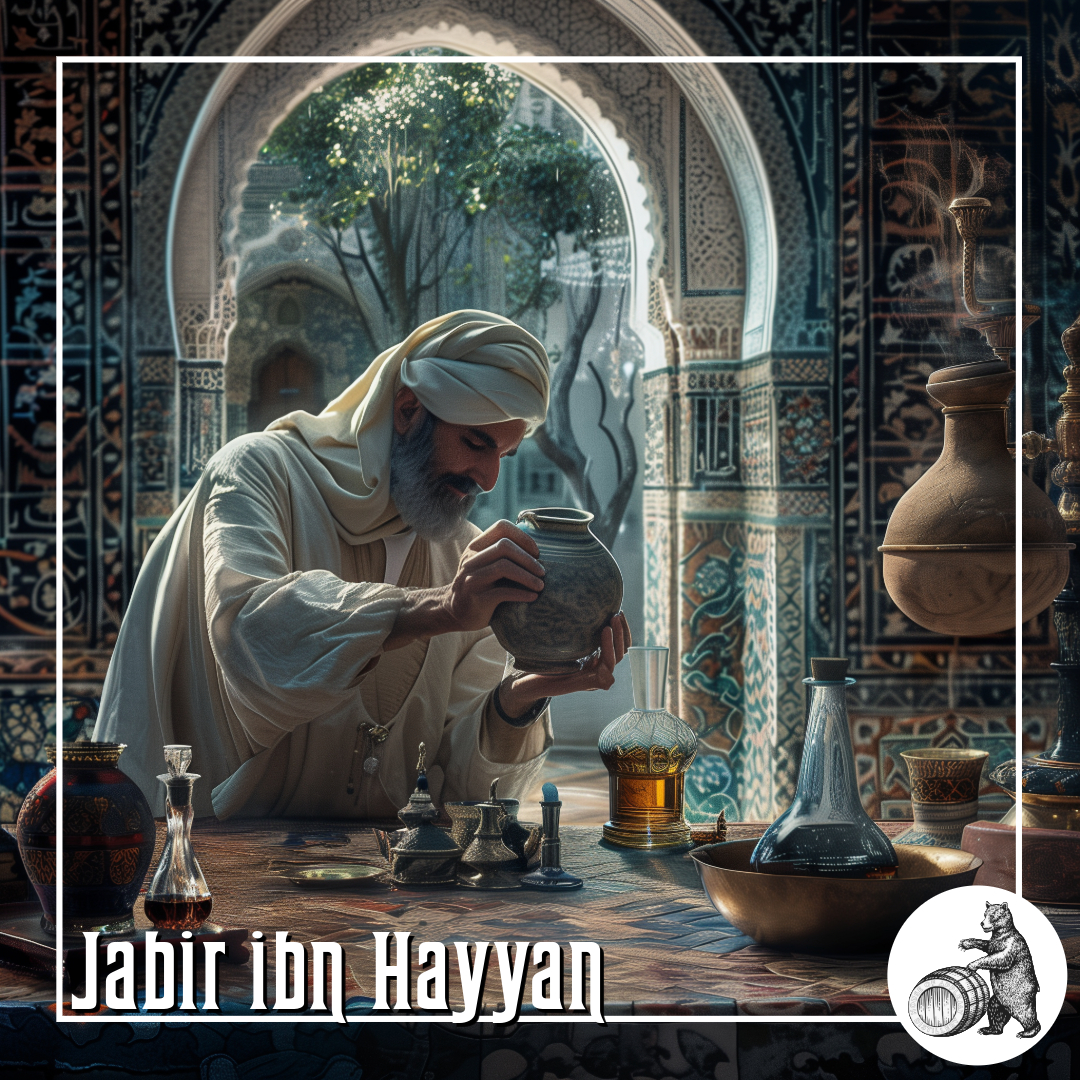Jabir ibn Hayyan
The Alchemist of the Islamic Golden Age
The Islamic Golden Age, spanning roughly from the 8th to the 14th century, was a period of remarkable advancements in science, medicine, and philosophy. Among the luminaries of this era, one figure stands out for his pioneering contributions to the field of alchemy and chemistry: Jabir ibn Hayyan, known in the West as Geber. Serving as the court alchemist to Caliph Harun al-Rashid, Jabir’s work laid the foundation for modern chemistry, particularly in the realm of distillation and the production of drinkable alcohol.
The Life and Legacy of Jabir ibn Hayyan
Jabir ibn Hayyan, whose full name is Abū Mūsā Jābir ibn Ḥayyān, is often referred to as the “father of chemistry” and the “father of alchemy.” His life is shrouded in mystery, with many details of his existence and works emerging from historical texts and later scholarly interpretations. Jabir is said to have lived in the 8th century, a disciple of the Shi’ite Imam Jaʿfar al-Ṣādiq. He served as a court alchemist to the Abbasid Caliph Harun al-Rashid in Baghdad, a hub of scientific and cultural activity during the Islamic Golden Age.
Jabir’s extensive body of work, known as the Jabirian corpus, comprises around 215 treatises that cover a vast array of subjects, including alchemy, chemistry, magic, and Shi’ite religious philosophy. His writings contain the earliest known systematic classification of chemical substances and detailed instructions for deriving inorganic compounds from organic materials. Notably, Jabir’s texts introduced many terms and concepts that remain integral to modern chemistry, such as the classification of substances into acids and alkalis—a term he coined.
The Alembic Still: A Revolutionary Invention
One of Jabir’s most significant contributions to the field of chemistry was the development of the alembic still, a device that revolutionized the process of distillation. The alembic consists of a container filled with a liquid, heated to produce vapors, which then pass through a tube into another vessel where they condense back into liquid form. This process allows for the separation and purification of substances based on their boiling points.
Jabir’s alembic still was initially constructed from glass or pottery, and it played a crucial role in the distillation of wine to produce alcohol. By heating wine in the alembic, the alcohol, which has a lower boiling point than water, would evaporate first. The vapors would then condense in a separate container, resulting in a more concentrated form of alcohol. This distilled product was referred to as “the spirit,” a term that would later become synonymous with distilled alcoholic beverages.
Jabir’s Impact on the Production of Alcohol
While Jabir’s primary focus was scientific rather than recreational, his work with the alembic still paved the way for the production of higher-proof alcoholic beverages. He noted that the distillation of wine produced a flammable vapor, which he described as “of little use but of great importance to science.” However, it is believed that the distilled alcohol was consumed during Jabir’s time, as evidenced by the writings of contemporary poets like Abu Nuwas, who extolled the virtues of a clear, potent drink that “burns inside the ribs as a burning firebrand.”
Jabir’s advancements in distillation techniques not only influenced the production of alcohol but also had far-reaching implications for the field of chemistry. The ability to separate and purify substances through distillation became a fundamental technique in both alchemy and early chemistry.
The Legacy of Jabir in Europe
The works of Jabir were translated into Latin in the 12th century, introducing European scholars to the sophisticated techniques of Islamic alchemists. By the early 13th century, distilled liquor, known as “aqua vini” or “the water of life,” was being produced in Spain, a region under Islamic influence. This knowledge significantly impacted the burgeoning field of alchemy in Europe, where scholars eagerly sought to decipher the secrets of these ancient texts.
Interestingly, the complexity and obscure language of Jabir’s writings led to the term “gibberish,” coined by European alchemists who struggled to understand the intricate details of his work. Despite these challenges, the scientific principles and methods described by Jabir laid the groundwork for the evolution of alchemy into modern chemistry.
Jabir ibn Hayyan, known as Geber in the West, was a towering figure in the history of alchemy and chemistry. His innovations in the distillation process, particularly the development of the alembic still, had a profound impact on the production of alcohol and the advancement of chemical techniques. Alongside contemporaries like Rhazes, who lived a century later, Jabir’s work during the Islamic Golden Age contributed to a legacy of scientific inquiry and discovery that transcended cultural and temporal boundaries. Their collective contributions not only shaped the field of chemistry but also bridged the gap between the ancient and modern worlds, leaving an indelible mark on the history of science.
The Distilling Culture
BLOG
Embark on a global journey, and you’ll find that cultures possess tales that harken back to their ancient beginnings of distillation, brewing, and winemaking.
info@houseofapplejay.com
67 Fowler St, Bldg B, East Ellijay, GA 30540

